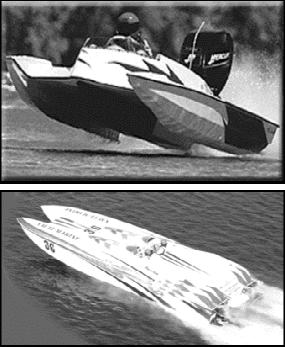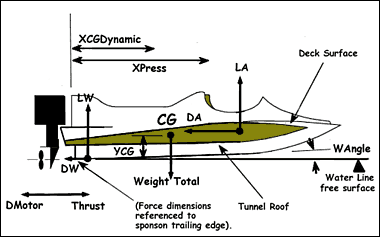| What makes the tunnel hull work?
Part I: Lift and Weight
by Jim Russell, AeroMarine Research
Background
The Tunnel Hull is a strange 'bird'. While the Tunnel derives much of its high performance from air lift, it depends at the same time on its planing interaction with the water to maintain a stable and controlled 'flight'. This interdependence of water and air force dynamics is the key to the approach to Tunnel design  |
Tunnel boats demonstrate such exceptional performance because they have a "wing" or aerofoil built-in to their design. The tunnel "roof" and the upper deck surface form the lower and upper surfaces of the aerofoil, respectively. When properly designed, it is this aerofoil, and the aerodynamic lift it generates, that gives the tunnel boat its great performance.
What makes the tunnel hull work? This is a multi-part article on the engineering basics of what makes the tunnel hull work. This week, we will look at the principles of operation and Lift/Weight balance.
To understand the balance of hydrodynamic and aerodynamic influences on tunnel boat performance and stability, we must examine the fluid dynamic forces involved. Several requirements must be satisfied for an object to maintain a steady straight-line velocity. (1) Lift = Weight. The weight for the hull must be exactly supported by forces such as lift from the hydrodynamic planing surfaces and aerodynamic lift. (2) Drag = Thrust. The drag experienced because of a velocity and all the lift mechanisms must be overcome by the available thrust. (3) Pitch = Null. All of these various forces acting must act so that the tendency to pitch about the center-of-gravity (CG) is eliminated.
Therefore, for a tunnel boat (as for any boat) these forces must all balance out - and the design of the hull can be thus generalized into the three areas of hull lift, hull drag and dynamic stability.
1 Lift and Weight
The hull weight (including engine, driver, fuel, accessories, payloads, etc.) must be EXACTLY equaled by the lift forces generated. This is true for any boat (or aeroplane, too) in stable flight. The tunnel hull must however always be in 'stable flight', and so this balance is especially critical. Too much lift and we take-off like an aeroplane - too little and we have more "down" than we have "up", and this can be a distressing event for a planing craft!
There is lift generated in two ways. The planing sponson bottoms create 'hydrodynamic' or water-lift (lift due to forces on and reactions with, the water surface). Aerodynamic lift is generated by the relative air flow over the tunnel and deck surfaces or "wing" (lift due to forces on and reactions with the air, itself). This aerodynamic lift is affected by several factors, just like a wing on an airplane. (thickness, camber, angle of attack, etc.). The additional influence is that of the "wing" being in what is called "ground-effect". With an airplane, it is experienced when the craft flies close to the ground during landing and takeoff. With a tunnel boat, it is experienced all of the time, due to the "wing's" proximity to the water surface. The effects are complex, but generally, lift is enhanced due to the "ground effect".
There are additional sources of lift in the tunnel hull rig, such as the slight lift generated by surface piercing propellers, for example, but the contributions of forces like these to the whole force 'picture', are smaller, and beyond this article.
It is important to note that the relative significance of these forces changes as the speed of the hull increases. We can see this reflected in Figure 1-1 showing the increasing aerodynamic lift and drag as functions of airspeed, for a typical Mod U/F1class racing tunnel boat of say 750 lbs. total weight and a constant angle of attack of about 2°. 
Figure 1-1 - Typical Air Lift/Drag vs. Velocity
Generally, under about 50 mph, the aerodynamic lift accounts for less than 10% of the total lift, the sponsons supporting nearly all of the weight of the boat. At the speeds now attainable by conventional racing tunnels, the tunnel lift can account for well over 80% of the total lift. This tells us then that the sponson lift is reduced accordingly which gives dramatic improvements in the performance of the boat, as we will see later.
The percent (%) Aerodynamic Lift (of Total Lift) on recreational boats is lower than it is on higher performance or race-type boats. I did a performance analysis of an STV Euro 19'. This boat generates 18% LA at mid velocity, and 29% (425 lbs) LA at maximum velocity. A similar analysis of a full race boat, like a Seebold F1 boat, shows that it generates 65% LA at top speed. The inherent design features contribute to the ultimate performance of different tunnel boat design concepts. The selection of each design feature is always somewhat of a compromise between top speed, acceleration capability, stability, comfort, seaworthiness and reliability.
The 'air-lift' of the Tunnel Hull is what separates this type of hull form from all the rest. Although the many factors affecting the aerodynamic forces generated make this a complicated matter at times, the effort is clearly worth it. Attention to detail in the design stages pays off many times over, in the end.
The main factors involved in creating the lift generated by the tunnel and the deck surfaces, or this 'wing' we have talked about, can be summarized as follows: (a) Airspeed
(b) Angle-of-attack
(c) Surface Area of Tunnel
(d) Aspect Ratio of Tunnel
(e) Height of mean camber line above the water surface
(f) Aerofoil shape of tunnel cross-section
(g) Surface condition of exposed areas

Figure 1-2 - Forces on a tunnel boat
The methods of calculations are presented in detail in the "Secrets of Tunnel Boat Design" book, but let us take a 'sneak-preview' of the design formula for air lift, so that we can see the relationships we are talking about.
LA = [½ ρAV2 SA CLA] ...(1)
where:
LA = air lift
ρA = density of air
V = velocity
SA = surface area
CLA = lift coefficient
Click here to continue to Part II - the drag and thrust relationship.
Get your full, illustrated, 11th edition copy of the "Secrets of Tunnel Boat Design" book, with over 165 pages of design practices and formulae and over 100 photographs.
The publications "History of Tunnel Boat Design" book, "History of Propellers" e-book, the "Tunnel Boat Design Program© for Win98" software, and the "PropWorks2" software for speed prediction and propeller selection are available at the Aeromarine Research web site. http://www.aeromarineresearch.com"Secrets of Tunnel Boat Design©" book - http://www.aeromarineresearch.com/stbd2.html "History of Tunnel Boat Design©" book - http://www.aeromarineresearch.com/history.html "History & Design of Propellers©" e-book - http://www.aeromarineresearch.com/historyofpropellers.html "Tunnel Boat Design Program© ", V6.5 software - http://www.aeromarineresearch.com/tbdp6.html "PropWorks2©" software for propeller selection and powerboat speed prediction - http://www.aeromarineresearch.com/prop2.html Copyright© 2002 AeroMarine Research®. All rights reserved.
No part of this report may be reproduced, transmitted, transcribed or translated into any language, in any form or by any means without the prior written permission of AeroMarine Research® or Jim Russell. Information in this report, and The Secrets of Tunnel Boat Design book© and the Tunnel Boat Design Program© , Version 6 for Windows 98/98se, is copyrighted by AeroMarine Research®.
| |